The Conception of the Contemporary Standard Express Passenger Locomotive by New Zealand Engineers and its World-Wide Appreciation
LOCOMOTIVES - 39
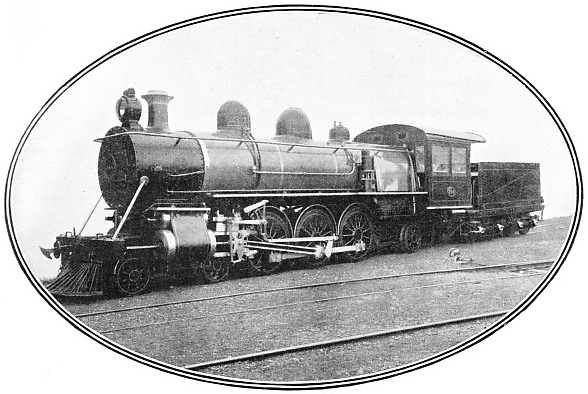
ONE OF THE FIRST “PACIFICS” 4-6-2 (“Q” CLASS, No. 344), FOR THE GOVERNMENT RAILWAYS OF NEW ZEALAND. It was designed by New Zealand Railway officials, and built by the Baldwin Company. Ready for the road, it scales 161,504 lb, and has a tractive effort of 18,350 lb.
THE dawn of the current century found the railways of the world once more confronted with the eternal problem of Traffic versus Motive Power. The “Atlantic” was holding sway, but it did not completely solve the issue; indeed, many locomotive engineers maintained that it did not present a sufficient advance upon the well-tried and trusted “American” type - seeing that it incorporated only the same number of coupled wheels, and consequently the same power of adhesion as the latter - tojustify its adoption upon their individual roads. Whatever advantage was forthcoming was declared to be more than off-set by the increased initial cost and maintenance charges.
As the result experiment was carried out at high pressure to meet the situation. Various wheel classifications within the limitations which ruled were tried in turn, but one and all led to the 4-6-0. This tended to force the conclusion that as more adhesive power was demanded, it would have to be provided by this arrangement of the wheels. The problem was solved in an unexpected quarter. Through the enterprise of the locomotive engineer to the New Zealand Government Railways, Mr. A. E. Beattie, the true type for which the railway world was searching was found.
During the opening weeks of 1901 the Baldwin Locomotive Company were asked to submit a design for a locomotive to burn lignite coal. The American company suggested the use of a wide fire-box of the Wootten type, and incorporated in a ten-wheeler 4-6-0. Upon investigation the proposed design was found to be unsuited to the New Zealand railways. The weight, with reasonable heating surface, exceeded the permissible axle-load limits, and so Mr. G. A. Pearson, then chief draughtsman of the Government system, elaborated his proposal for meeting the situation. As this was endorsed by Mr. Beattie the accompanying sketch design was prepared, and forwarded to the Baldwin Works for elaboration in detail.
The design, when investigated by the American locomotive technicians, was discovered to be a new type from the addition of a trailing axle to the ten-wheeler, giving the wheel arrangement 4-6-2. The sketch design worked out by Mr. Pearson conveyed certain specific, limitations, namely, cylinder, wheel and overall dimensions. The weight carried upon the leading truck was not to exceed 25,000 lb, while the drivers were to carry 62,000 lb equally distributed over the three axles.
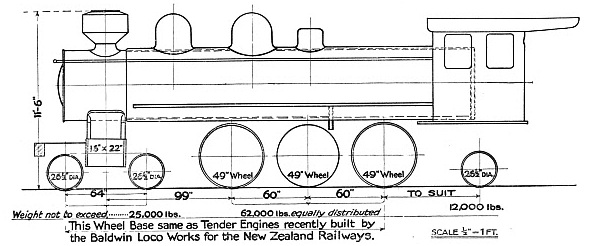
SKETCH DESIGN OF THE FIRST “PACIFIC”, NO. 338, OF THE “Q” CLASS, TO RUN ON THE NEW ZEALAND GOVERNMENT RAILWAYS, 1901.
The locomotive was built, and the first of the fleet of thirteen, Nos. 338 to 350, ordered from the Philadelphia works, was delivered to the New Zealand Government late in 1901 to form the official class “Q”. They are identical, with cylinders 16 by 22 inches connected to the six-coupled driving wheels 49⅛ inches in diameter. The leading truck wheels are 26¼, and the trailing wheels 30¼ inches in diameter, respectively. The boiler, carrying 1,569 tubes, 2 inches in diameter, has a heating surface of 1,569 square feet, and the fire-box 114 square feet, giving a total heating surface of 1,683 square feet; the grate area is 40 square feet. The working pressure of the boiler is 200 lb, and the Walschaert valve motion is fitted.
The leading truck carries 21,280 lb; the three driving axles 68,880 lb; of the latter weight 22,624 lb are borne by the first and third axles, and 23,632 lb by the central axle; the trailing axle bears 17,360 lb. The eight-wheeled tender has capacity for 1,700 gallons of water and space for 11,200 lb of fuel. The overall length of the locomotive is 55 feet 4¾ inches; total wheel-base is 48 feet 3¾ inches, and engine wheel-base 26 feet 3 inches. In working order the locomotive scales 161,504 lb, the engine accounting for 107,520 lb, with 68,880 lb available for adhesion. The tractive effort is 18,350 lb.
From the fact, that this locomotive was evolved from the ten-wheeler through the enterprise of the engineers to the railways of the British Dominion set in the Pacific Ocean, and because it first demonstrated its possibilities there, it became known as the “Pacific”. This generic description, continuing marine nomenclature, is fortunate, inasmuch as the distinction of having been the first to exploit the 4-6-2 lies between the railways of New Zealand and West Australia. By a strange coincidence the engineers to the latter independently conceived and built a locomotive having this wheel arrangement, and it went into service about the same time as the first of the thirteen Baldwin 4-6-2 locomotives was put through its paces upon the Government system of the sister Dominion.
The “Pacific” satisfied the requirements of the New Zealand system very effectively, but did not arouse widespread enthusiasm elsewhere, for the simple reason that the “Atlantic” had not been carried to its limits of development at that date. The power issue reached its really acute stage upon the American continent with the coming of the all-steel passenger coach - which was not only longer but heavier than its wooden rival. At the same time the standard train had to be increased to ten cars in order to cope with the volume of passenger traffic. The public insisted upon the maintenance of the existing speeds, if not actual acceleration of the services, despite the increase in the weight of the trains, and it became necessary to discover a more powerful motive unit; even the largest and most powerful “Atlantics” were now outclassed.
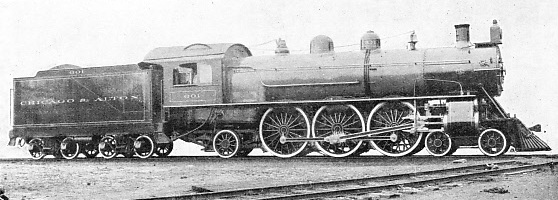
A BALDWIN “PACIFIC” OF 1903. It was built for the Chicago and Alton Railway to haul the heavy excursion trains to the St. Louis Exhibition. The driving wheels are 80 inches in diameter, overall length, 62 feet; tender capacity, 8,400 gallons of water and 9 tons of coal; the weight in working order is 130 tons.
The railway companies, impressed with the successful operation of the 4-6-2 locomotives upon the New Zealand railways, forthwith adopted the “Pacific”, because it gave just those essentials for which they were diligently seeking. Rapid development ensued, not only throughout North America but in Europe also, inasmuch as the very factors which led to its recognition in the former were harassing the railways of Germany, France, Austria and Italy, particularly in the movement of the long-distance expresses. The evolution of the “Pacific” was more intensified than had been that of the “Atlantic”, owing to the incidence of the pressure of the economic issue. Within a short time it displaced all other types for express passenger traffic, and now ranks as the standard therefor throughout the world, except upon the mountain divisions of the great systems.
The “Pacific” made its debut in Great Britain during 1908, the Great Western initiating the movement with “The Great Bear” with four cylinders, 15 by 26 inches, working at a pressure of 225 lb of steam raised in a boiler 23 feet in length by 72 inches, tapering to 66 inches, in diameter. The total heating surface, including superheater, is 3,154 feet. The driving wheels are 80½ inches in diameter; tractive effort 27,800 lb.

THE FIRST BRITISH EXPRESSION OF THE “PACIFIC” APPEARED ON THE GREAT WESTERN RAILWAY, 1908. It has 80½-inch driving wheels, and a tractive effort of 27,800 lb.
The Great Northern (now part of the London and North Eastern Railway), which introduced the “Atlantic” to Great Britain, turned to the “Pacific” for the haulage of the heavy Scottish expresses in 1922. This locomotive “Great Northern” has three cylinders 20 by 26 inches. The heating surface is 3,455 square feet - tubes 2,715, fire-box 215, and superheater 525 square feet respectively - and a grate area of 41·25 square feet. The boiler pressure is 180 lb. The diameter of the wheels of the leading bogie is 38 inches; of the coupled drivers 80 inches; and of the trailing wheels 44 inches. The engine weighs 92·45 and the tender 56·3 tons, bringing the total weight of the locomotive to 148¾ tons.

GIANT “PACIFIC” INTRODUCED UPON THE GREAT NORTHERN RAILWAY FOR ITS SCOTTISH EXPRESS TRAFFIC, 1922. It has 80-inch driving wheels and a total weight of 333,200 lb.
Upon the introduction of the ten-car all-steel train in the United States the Philadelphia and Reading Railway, always jealous of its high-speed reputation, and finding it impossible to maintain its 55 minutes’ schedule over the 55½ miles between Camden and Atlantic City with the most powerful “Atlantics” built specially for this service in 1915, turned to the 4-6-2 type, which was doing excellent duty in express passenger service upon other roads. The first representative of this family, designed by Mr. I. A. Seiders, superintendent of motive power, emerged from the Reading shops in 1918. This carried steam at 200 lb, but in the latest members of the family, built in 1922, the pressure was raised to 220 lb. These have proved so uniformly successful that the pressure of the earlier machines is being increased to the latter figure as they pass into the shops for overhaul.
These “Pacifics” are essentially high-speed machines, combining the fast-running and other outstanding qualities of the “Atlantics” with increased hauling capacity. They have cylinders 25 by 28 inches; boiler 72 inches in diameter, with combustion chamber 48 inches long, carrying 193 tubes, 19 feet in length by 2¼ and 5½ inches diameter; the fire-box measures 126¼ by 108¼ inches; while the grate area is 94·5 square feet. The water-heating surface is 2,927 square feet, and of the superheater 848 square feet, giving an aggregate heating surface of 3,775 square feet. The driving wheels are 80 inches in diameter. The tender, mounted on two four-wheeled trucks, carries 15 tons of fuel and 9,000 gallons of water. The overall length of the locomotive is 71 feet 8½ inches, and it weighs, complete, 450,000 lb; of this amount the engine represents 273,600 lb, with 178,900 lb on the drivers; the tractive force is 40,900 lb.

POWERFUL “PACIFIC” INTRODUCED ON THE PHILADELPHIA AND READING RAILROAD, 1918. This type was built to maintain the 55 minutes’ service between Camden and Atlantic City, when the introduction of heavier rolling stock proved to be above the capacity of the “Atlantics”.
Twenty-five of these locomotives are in service, working the three daily expresses between Philadelphia and Atlantic City, and also those running between the former city and New York, as well as other points on the main line, hauling ten- and twelve-car trains. Each of the standard steel coaches weighs 117,600 lb, so that the weight of the fully laden train behind the engine ranges approximately from 1,286,000 to 1,546,000 lb - about 574 to 690 tons. This load is moved over the 55½ miles between Camden and the coast in 55 minutes without a stop; while similar loads are hauled over the 90 miles between Philadelphia and New York, a more difficult road, in 108 minutes, including four stops and several service slacks.
The “Pacific” has also found widespread favour upon the Canadian railways, owing to the similarity of the conditions prevailing in both countries. Those on the Canadian Pacific expresses, which were built in the workshops of the company, have cylinders 25 by 30 inches, and driving wheels 75 inches in diameter. The boiler has a maximum outside diameter of 88 inches, carrying steam at 200 lb per square inch. The firebox totals 111⅛ inches in length by 83⅜ inches in width. The water-heating surface is 3,529·6 square feet; of superheater 903 square feet. The grate area is 65 square feet. The tender of the eight-wheeled type, 32 feet 5 inches in length, carries 8,000 imperial gallons of water and 12 tons of fuel, and weighs 178,800 lb. The overall length of the locomotive is 67 feet 1 inch; total weight in working order 476,800 lb; of this amount 298,000 lb. represents the weight of the engine with 180,700 lb on the driving wheels. The maximum tractive power is 42,500 lb.
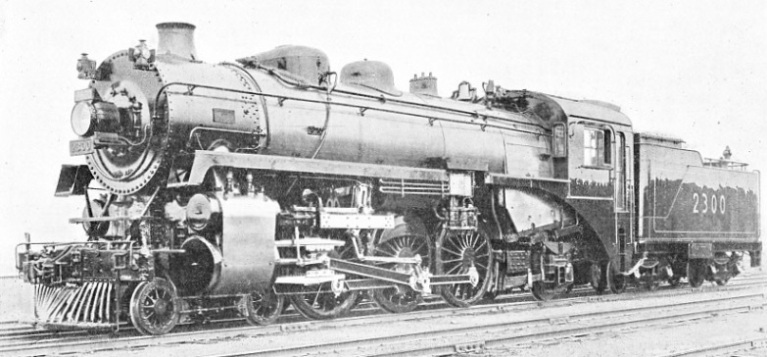
AN EXPRESS “PACIFIC” OF THE CANADIAN PACIFIC RAILWAY. It has an overall length of 67 feet 1 inch; 75-inch driving wheels; a tender of the eight-wheeled type; and a total weight, in working order, of 476,800 lb.
Nearly every American system has its fleet of “Pacific” locomotives, standardized for express passenger service, and many of these are magnificent expressions of locomotive engineering. Among them may be mentioned those of the Pennsylvania Railroad. These have cylinders 27 by 28 inches, using steam at a pressure of 205 lb, with driving wheels 80 inches in diameter. The boiler, of the Belpaire wide fire-box type, with minimum internal diameter of 76⅝ inches, equipped with superheater, has 436 tubes, 228 inches in length, giving a total heating service of 3,735 square feet, which, with the superheater surface of 1,215 square feet and 315 square feet area of the fire-box, brings the total heating surface to 5,265 square feet. The grate, 80 by 126 inches, has an area of 70 square feet. The total weight of the locomotive, which has a wheel base of 71 feet 10 inches, is 467,890 lb; of this amount the tender weighs, loaded, 159,000 lb. Of the 308,890 lb representing the weight of the engine, 201,830 lb are imposed upon the driving wheels. The tractive power is 44,460 lb, the ratio thereof to the weight on the driving wheels, the factor of adhesion, reading 4·54.
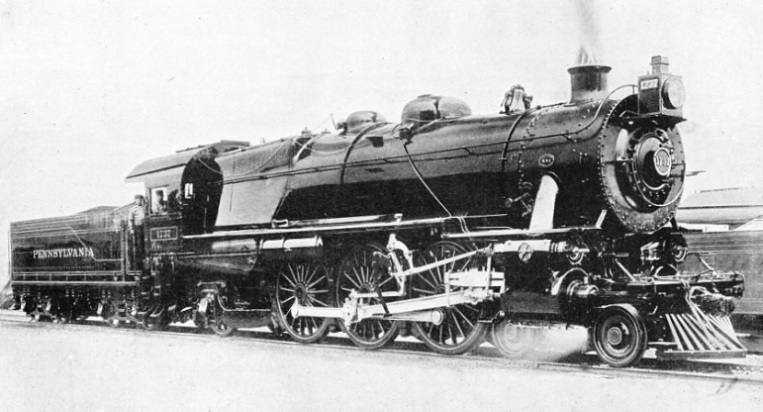
PENNSYLVANIA RAILROAD’S “PACIFIC” (K4s TYPE) FOR EXPRESS PASSENGER SERVICE. It has cylinders 27 inches in diameter by 28-inches stroke, and a steam pressure of 205 lb per square inch. The total heating surface is 5,265 square feet. It has 80-inch driving wheels and, ready for the road, the complete locomotive scales 467,890 lb.
The “Pacific” has met with widespread recognition upon the European continent, notably in France; for the State railways of that country an imposing fleet was built by the North British Locomotive Company during the Great War. The French locomotive industry suffered from severe disturbance as the result of hostilities and the pressure of the demand for materiel de guerre in motive power. The British-built locomotives are compound with high- and low-pressure cylinders of 16 17/32 and 25 3/16-inches respectively in diameter, by 25 9/16 inches stroke. The boiler, working at a pressure of 227 lb per square inch, has tubes giving 2,105 square feet of heating surface; while that of the fire-box is 177 square feet which, with 682 square feet of superheater, gives an aggregate heating surface of 2,964 square feet. These heating surfaces, in accordance with the French practice, are measured on fire-contact surfaces. The grate area is 45·9 square feet.
The coupled driving wheels have a diameter of 76⅜ inches; that of the front bogie truck wheels is 37 13/16 inches, and of the trailing wheels 48⅜ inches. The rigid wheel base is 13 feet 51 7/16 inches; of engine 35 feet 9 3/16 inches; of engine and tender 64 feet 3⅜ inches. The tender, mounted on two four-wheeled bogie trucks, has capacity for 4,840 gallons of water and 265 cubic feet of coal, and weighs in laden condition 115,696 lb. The weight of the complete locomotive, ready for service, is 328,496 lb, and the engine scales 212,800 lb, with 127,120 lb available for adhesion. At 50 per cent, of the boiler pressure the draw-bar pull is 20,760 lb.
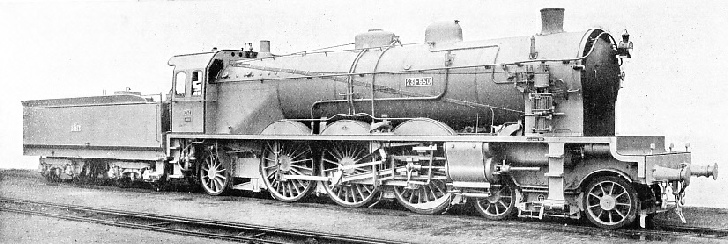
NORTH BRITISH LOCOMOTIVE COMPANY’S “PACIFIC” BUILT FOR THE FRENCH STATE RAILWAYS DURING THE WAR. Ready for the road, the locomotive scales 328,496 lb. It has a boiler pressure of 227 lb per square inch, and at 50 per cent of the latter exerts a draw-bar pull of 20.760 lb.
For high-speed passenger duty through give-and-take country the “Pacific” has proved the most generally successful type yet evolved, and with the accumulation of experience is undergoing certain modifications. Thus upon those systems traversing relatively flat or easy country there is the “light” type; while for such roads as are to be found in the North and West of England, with short sharp grades, a “medium” or “medium light” design is favoured; the heaviest and most powerful units are reserved for use in hilly country where, although the topographical conditions cannot be described as strictly mountainous, they approach that character. Flexibility of design, to meet varying physical road requirements, is responsible for the universal recognition of the 4-6-2.
You can read more on “The Development of the Decapod”, “A Famous Locomotive Type”, and “The Story of the Atlantic” on this website.











